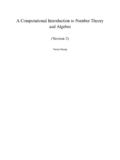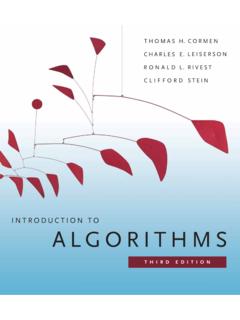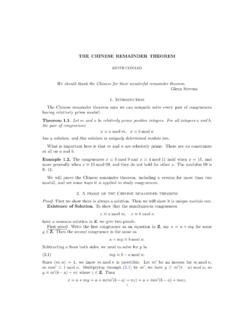Search results with tag "The chinese remainder theorem"
A Computational Introduction to Number Theory and …
shoup.net2.4 The Chinese remainder theorem 22 2.5 Residue classes 25 2.6 Euler’s phi function 31 2.7 Euler’s theorem and Fermat’s little theorem 32 2.8 Quadratic residues 35 2.9 Summations over divisors 45 3 Computing with large integers 50 3.1 Asymptotic notation 50 3.2 Machine models and complexity theory 53 3.3 Basic integer arithmetic 55 3.4 ...
Introduction to Algorithms, Third Edition
bayanbox.ir31.5 The Chinese remainder theorem 950 31.6 Powers of an element 954 31.7 The RSA public-key cryptosystem 958? 31.8 Primality testing 965? 31.9 Integer factorization 975 32 String Matching 985 32.1 The naive string-matching algorithm 988 32.2 The Rabin-Karp algorithm 990 32.3 String matching with finite automata 995? 32.4 The Knuth-Morris ...
The Chinese Remainder Theorem - Loyola University Chicago
gauss.math.luc.eduBy solving this by the Chinese remainder theorem, we also solve the original system. (The solution is x 20 (mod 56).) Of course, the formula in the proof of the Chinese remainder theorem is not the only way to solve such problems; the technique presented at the beginning of this lecture is actually more general, and it requires no mem-orization.
The Chinese Remainder Theorem - homepages.math.uic.edu
homepages.math.uic.eduChinese Remainder Theorem tells us that there is a unique solution modulo m, where m = 11 ⋅ 16 ⋅ 21 ⋅ 25 = 92400. We apply the technique of the Chinese Remainder Theorem with k = 4, m 1 = 11, m 2 = 16, m 3 = 21, m 4 = 25, a 1 = 6, a 2 = 13, a 3 = 9, a 4 = 19, to obtain the solution. We compute z 1 = m / m 1 = m 2 m 3 m 4 = 16 ⋅ 21 ...
The Chinese Remainder Theorem
www-math.ucdenver.eduFind the smallest multiple of 10 which has remainder 2 when divided by 3, and remainder 3 when divided by 7. We are looking for a number which satisfies the congruences, x ≡ 2 mod 3, x ≡ 3 mod 7, x ≡ 0 mod 2 and x ≡ 0 mod 5. Since, 2, 3, 5 and 7 are all relatively prime in pairs, the Chinese Remainder Theorem tells us that
THE CHINESE REMAINDER THEOREM
kconrad.math.uconn.eduThe Chinese remainder theorem can be extended from two congruences to an arbitrary nite number of congruences, but we have to be careful about the way in which the moduli are relatively prime. Consider the three congruences x 1 mod 6; x 4 mod 10; x 7 mod 15:
THE CHINESE REMAINDER THEOREM - UCONN
www.math.uconn.eduThe Chinese remainder theorem says we can uniquely solve any pair of congruences that have relatively prime moduli. Theorem 1.1. Let m and n be relatively prime positive integers. For any integers a and b, the pair of congruences x a mod m; x b mod n






